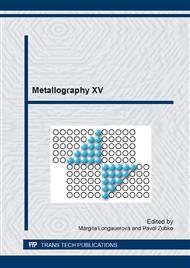p.335
p.339
p.347
p.353
p.359
p.365
p.369
p.373
p.379
The Study of Iron Intermetallic Phases Morphology with Applying Deep Etching in Secondary Al-Si Alloys
Abstract:
The morphology control of intermetallic phases is very important in secondary aluminium cast alloy, because these alloys contain more of additional elements, which forms various intermetallic phases in the structure. Improvement of the mechanical properties is strongly depending upon the morphology, type and distribution of the second phases, which are in turn a function of the alloy composition and cooling rate. The iron intermetallic phase has the greatest influence on mechanical properties. It is necessary to study microstructure of Al-Si alloys, because the metallographic evaluation of aluminium alloys is not simple and these alloys are used for production many mechanical components, especially for cars, aerospace and rail vehicles. The study of iron intermetallic phases was performed using light microscope Neophot 32 and SEM observation with EDX analysis. For study the morphology of these phases were samples deep-etched for 30 s in HCl solution, in order to reveal the three-dimensional morphology of the iron phases.
Info:
Periodical:
Pages:
359-364
Citation:
Online since:
April 2014
Authors:
Price:
Сopyright:
© 2014 Trans Tech Publications Ltd. All Rights Reserved
Share:
Citation:


